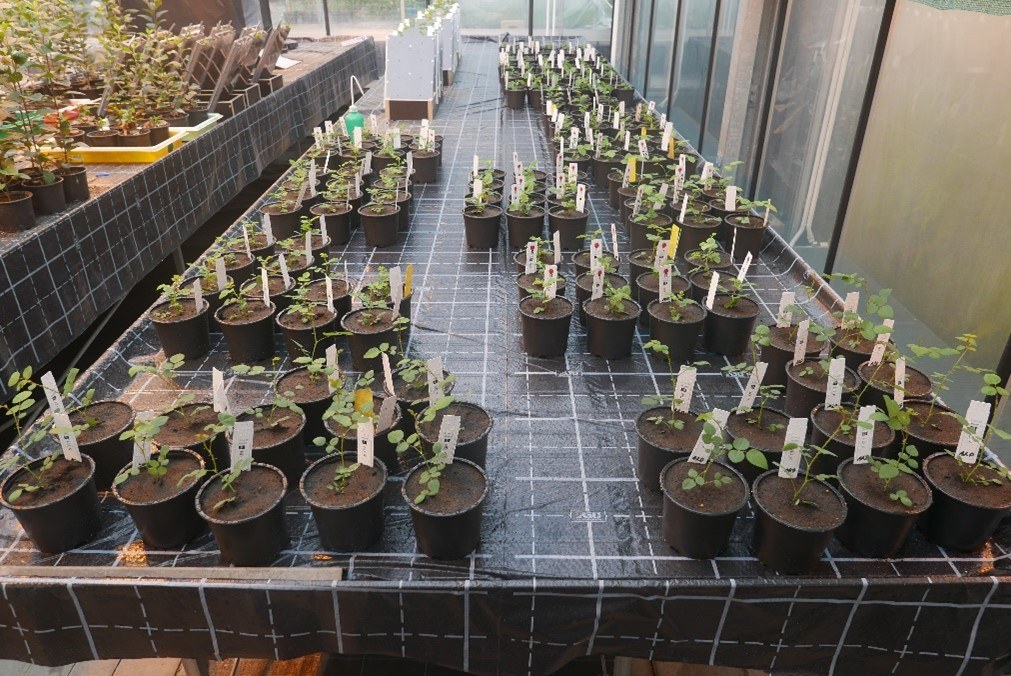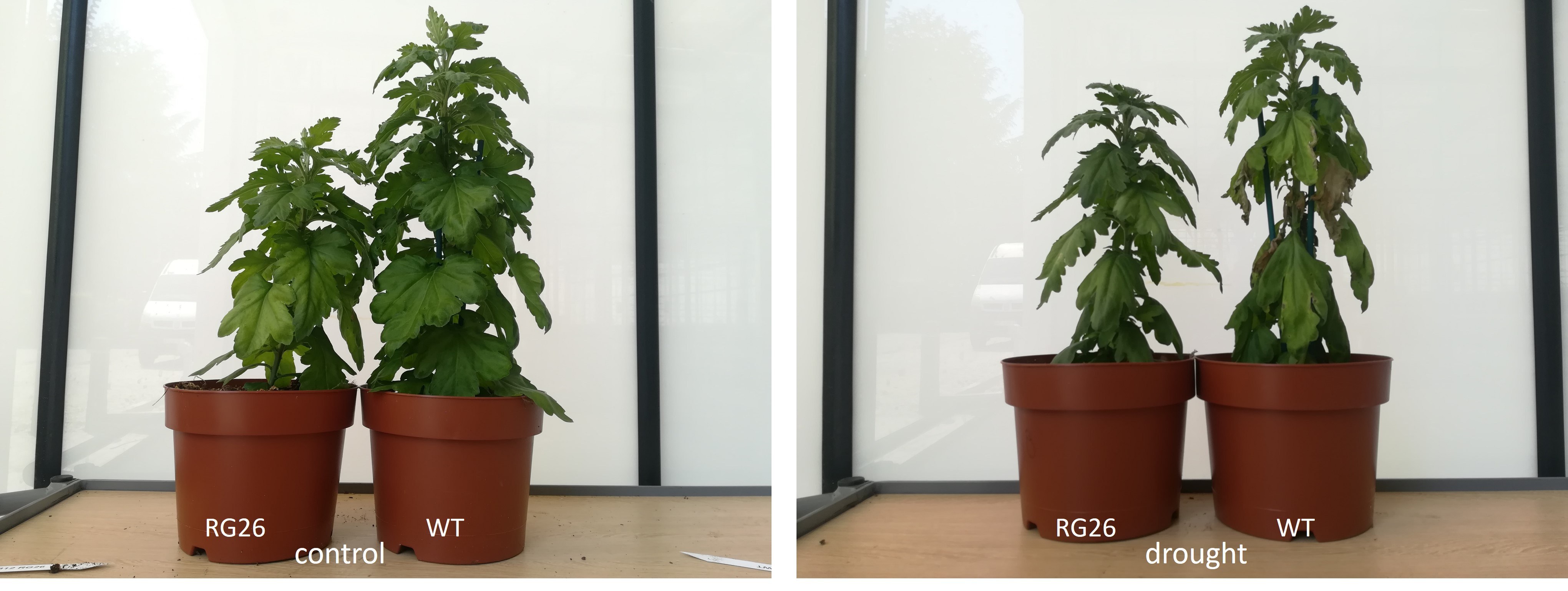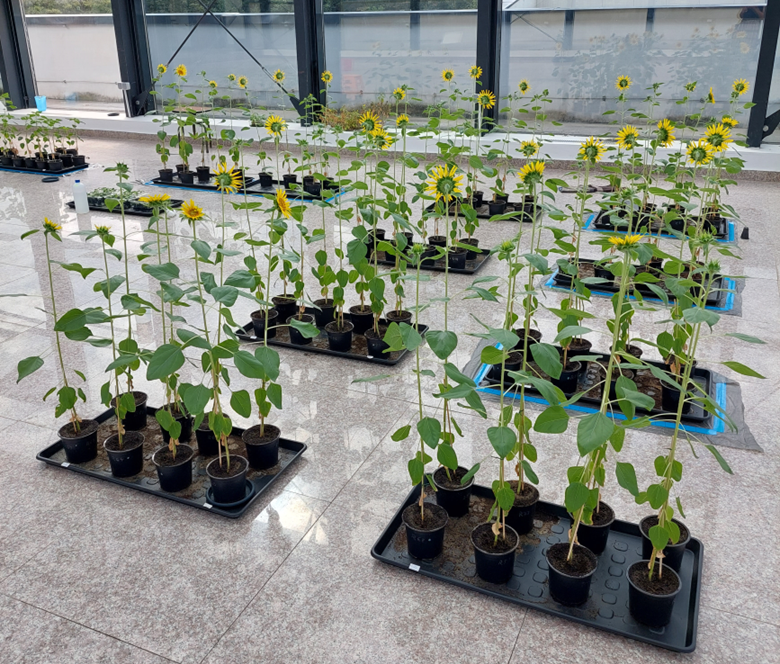Results
The RootsPlus project is reaching its final quarter and we are pleased to update on the results each (scientific) partner obtained so far.
EV ILVO
For one of our private partners, we have further optimised the protocol to obtain Ri-plants from recalcitrant chrysanthemum genotypes. A genotype screen using a fluorescent bacterial strain identified some genotypes for which it is more difficult for the bacteria to enter the plant, but for the majority of the genotypes, obtaining hairy roots is not problematic but rather the regeneration of shoots from these roots is the biggest bottleneck. Our experiments show that at least for some of the recalcitrant genotypes, regeneration at low efficiency could be induced. Furthermore we are continuously optimising some molecular tools to screen the regenerated plants, such as the dPCR assay to determine the exact copy-numbers of the inserted genes. For this purpose finding the best reference genes remains a challenge. Fluorescent In-Situ Hybridisation (FISH) resulted in the identification of the positions on the chromosomes where the Ri genes were inserted and will further be implemented on the F1 plants from the company's breeding program with the Ri plants. This season Ri plants were also phenotyped extensively during plant growth regulator trials and rooting experiments. Also F1 and F2 populations were evaluated on the field.
Also for apple we collaborate with a private company. Likewise as the colleagues of LUH, we have been able to optimise the protocol to such an extent that we regenerated shoots originating from the same rootstock and scion cultivar. Based on the first results, we also established coculture experiments with several cultivars/rootstocks of the company's genepool. Also on this material, shoots were regenerated, albeit at lower frequency than on the aforementioned test cultivars/rootstocks. Copy-number quantification of the inserted genes is currently ongoing on all obtained shoots. The first shoots are now also acclimatized and ready for a first phenotypic evaluation at the company in 2024.

LUH
The protocols for hairy root induction in rose and apple and subsequent regeneration of Ri plants from apple hairy roots were established and optimized with the help of two BSc students and two MSc students. For rose, whole leaves formed hairy roots at a higher percentage than petioles or leaflets and sonication treatments improved the transformation efficiency in general. This optimized hairy root induction protocol has been applied to phenotype 104 rose genotypes for the subsequent genome-wide association study (GWAS). Five interesting genomic regions were identified, that are associated with transformability by R. rhizogenes and explain 12 – 27 % of the overall phenotypic variance. Results on potential candidate genes are expected in the beginning of 2024. High integration frequencies of T-DNA genes into roots formed on leaf explants of 88 % were proven for roses. Furthermore, from established, continuously growing rose hairy root cultures samples were sent to our partners at NCU for plant hormone profiling next to root samples from acclimatized Ri plants.
Also, for apple the protocol for induction of hairy roots was established in close collaboration with partners at ILVO. Hairy root induction was achieved for every rootstock (4) and scion (2) cultivar. Most of the 16 bacterial strains tested induced hairy roots, with agropine strains having the highest efficiency. For apple, the T-DNA integration rate in roots formed on leaf explants was 94 %.
Apparently, regeneration of Ri plants was easier in apple than in rose. By now, we have Ri plants regenerated from hairy roots of two apple genotypes which were proven to contain rol-genes. For rose, regeneration seems quite difficult since several experiments following different approaches for regeneration and applying diverse plant growth regulator combinations and concentrations were not successful. Nevertheless, some spontaneous regenerants from hairy root cultures were obtained and propagated and, together with apple Ri lines, morphologically characterized and tested for replant disease tolerance in a greenhouse experiment. We observed a typical strong Ri phenotype in the shoot architecture for both species but the reaction on replant disease-affected soils tolerance needs further investigation.

NCU
In the scope of the 3rd area of the study, the ability of Ri plants to tolerate drought was assessed and compared to the untransformed plants. The experimental setup involved three chrysanthemum genotypes. Within each of them, a line containing the Ri genes (RG) and an isogenic line representing the wild-type (WT) plants were included. The experiments were conducted under greenhouse conditions, on plants at the vegetative developmental stage and grown in garden soil-filled pots. Subjecting plants to drought stress consisted in treating plants with water deficit over an 8-day-long drought period. After that, on the 9th day after cessation of watering, the plants were watered to recover from drought. The analysis were carried out at two-day intervals, starting from the day of the beginning of the drought treatment, until the 1st day after the watering was reestablished. This approach enabled to study the plants reactions to progressing drought as well as their ability to return to the normal course of physiological processes after the watering was restored. The analysis performed included the measurement of photosynthesis-related processes, chlorophyll fluorescence, relative water content (RWC) in leaves, water potential in leaves, electrolyte leakage, fresh and dry weight of plants above-ground parts and the root systems. In addition, the leaf, stem and root samples were collected for future analysis of osmoprotectant and abscisic acid content.
It was revealed that the decrease in the photosynthetic activity under water deficit was significantly smaller in the leaves of the Ri plants than in the WT. Depending on the genotype, a significant difference in the CO2 assimilation rate between Ri and WT plants appeared after 2 to 4 days of water deficit treatment. Similar patterns of the drought response were revealed for the transpiration rate and stomatal conductance. These parameters also remained at higher levels in Ri plants. After re-supplying water, the Ri plants recovered the initial levels of photosynthetic intensity, transpiration and stomatal conductance faster than the WT plants. The observed changes correlated with the water content in the pots. For all genotypes, a significant decrease in the soil water content was observed after 5-6 days of water deficit. Our results indicate that Ri plants photosynthesize more efficiently under drought conditions than plants without Ri genes, and the Ri plants re-establish high photosynthetic rates faster after restoring irrigation. The leaf RWC analysis revealed that both in WT and Ri plants, the value of the parameter was decreased under water deficit. However, the observed decrease in RWC was significantly smaller in Ri plants than in WT plants. An alternative way to express the water status of plant tissues is the analysis of water potential. The measure of this parameter decreased significantly under drought conditions. However, the leaves of the RG line plants showed a significantly smaller reduction in water potential than the leaves of non-transformed plants, representing the same genotype. Like the other results described above, they suggest increased drought tolerance of Ri plants, compared to conventional plants.

UASVMCN
For the Romanian partner, represented by UASVM-CN and financed by the UEFISCDI, the goal of the project is to establish a biotechnological method for improving the root system in sunflower by using the transformation with Rhizobium rhizogenes to obtain plants better adapted to water stress.
The first objective was to establish a method for obtaining transformed roots (Ri roots) and this was achieved by finding a protocol that was applied to several sunflower genotypes and adapted for transformation of H. tuberosus, too. Now, continuous Ri roots production is possible, and it is necessary for accomplishing the second objective which is the finding a way for regeneration of Ri plants. Although the conversion of the laterally root meristems into shoot meristems was observed, particularly for H. tuberosus Ri roots, the regeneration of Ri plants has not yet been achieved. Preliminary tests of the endogenous growth regulators in the Ri roots, analyzed by the project partner NCU, highlighted the lack of cytokinins. Having this information, different cytokinins were supplemented in the culture media aiming to induce plant regeneration from these roots. However, a method of plant regeneration has not yet been established. To replace the presence of transformed plants, we obtained composite plants through a very efficient method. These composite plants proved to be a very good model for analyzing the functionality and the phenotype of the transformed roots in a fully grown plant, which is the third objective for the UASVM-CN partner. For that we developed a hydroponic culture system followed by culture in soil of the sunflower composite plants which showed better growing of the Ri roots compared with the control ones, resulting in a better growing of the plants. The fourth objective was to test the performances of these roots in water stress condition. For accomplishing that we established the protocol for watering and analyzing the plants. The tests are ongoing aiming to validate the results.

